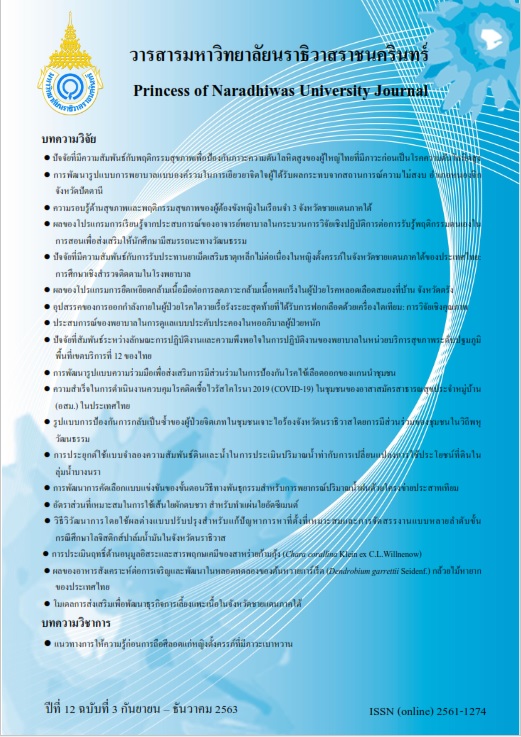Appropriate Ratio for Using Water Hyacinth Fibers for Making Cement Fiberboard
Keywords:
Water Hyacinth fiber, Cement fiberboard, Thermal insulationAbstract
The objective of this research was to study a suitable ratio of using water hyacinth fiber as a mixture of high-density cement fiber board. The admixtures consisting of cement, fine sand, water hyacinth fibers, water, and cement forming accelerators (Aluminium Sulphate (Al2(SO4)3), Calcium Chloride (CaCl2), Sodium Silicate (Na2SiO3)) were respectively mixed in 5 mixing ratios by weight: 1: 0.2: 0.3: 0.000: 0.03, 1: 0.2: 0.3: 0.025: 0.03, 1: 0.2: 0.3: 0.05: 0.03, 1: 0.2: 0.3: 0.075: 0.03 and 1: 0.2: 0.3: 0.1: 0.03. A total of 20 mixing formulas were used in forming cement board sheets with a compactor. The sheets were then tested for the properties in compliance with TISI 878-2537: Standard for High-Density Cementitious Veneer. From the results at 28 days of curing, Formula B3 ratio of 1: 0.2: 0.3: 0.05: 0.03 (cement: fine sand: water hyacinth fibers: Calcium Chloride (CaCl2)) was the most suitable ratio as the properties met the standard, TISI 878-2537 (only the bending strength was slightly lower than the standard).
References
Boonyarit, J., Kongtud, W., Witayakran, S., Ngamroj, C., & Chollakup, R. (2016). Physical properties of water hyacinth for O.E. spinning water hyacinth/cotton fiber blended yam. The 54th Kasetsart University Annual Conference. February 2-5, 2016.
Chatveera, B. & Nimityongskul, P. (1994). Use of Water Hyacinth Fiber as Randomly-OrientedReinforcement in Roofing Sheets, KKU Engineering Journal, 21(1), 77-92.
Chongjit, W. (2012). Design of lounge chairs from palm fiber, woven sheet and rubber. Independent research Master of Arts Program. Department of Product Design. Silpakorn University. (in Thai).
Department of Industrial Promotion. (1996). Cement bonded particleboards. Department of Industrial Promotion Ministry of industry. (in Thai).
Homaswin, K. (2016). Absorbent insulating sheet. 12th Year. No. 3503, p. 13, Ban Muang Thai newspaper. (in Thai).
Israngkoon, B., Chantawong, P. & Ungkoo, Y. (2010). Study of Mechanical Properties of Autoclaved Aerated Lightweight Concrete Element Containing Microfiber. Journal of Science Ladkrabang, 19(2): 59-68.
Jaktorn, C. & Jiajitsawat, S. (2014). Production of thermal insulator from water hyacinth fiber and natural rubber latex. NU. International Journal of Science. 11, 31-41.
Jindaprasert P., Jaturapitakkul C. (2012). Cement, Pozzolan, and Concrete. 7th ed. Bangkok: ACI Partners with Thailand Concrete Association. (in Thai).
Sayrumyat R., Suriwong V., Inriral, P. & Sumrit, T. (2016). The Design and building of a floating plantation raft by water hyacinth. Prawarun Agricultural Journal. 13(2), 227-233.
Thai Industrial Standards Institute (TISI). (1994). Thai Industrial Standard no.878-1994: Cement Bonded Particle Board: High Density. Bangkok: Thai Industrial Standards Institute. (in Thai).
Vasasiri, B. (2015). Hyacinth fiber fabric to mix with cotton thread, Journal Art Klong Hok, 2, 210-227.
Young, H.D. (1992). Hyper Physics. Addison Wesley: University Physics.




